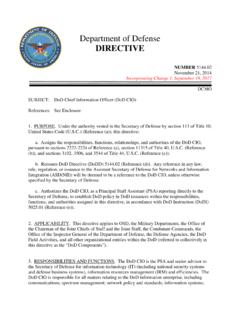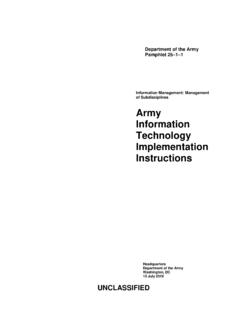Transcription of Army Use of the Electromagnetic Spectrum
1 UNCLASSIFIED Army Regulation 5 12 management Army Use of the Electromagnetic Spectrum Headquarters Department of the Army Washington, DC 8 February 2020 SUMMARY of CHANGE AR 5 12 Army Use of the Electromagnetic Spectrum This major revision, dated 8 February 2020 o Updates policy to reflect organizational changes within the Department of the Army (chap 2). o Includes minor corrections to editorial oversights of the last major revision to this regulation (throughout). *This regulation supersedes AR 5 12, dated 16 February 2016. AR 5 12 8 February 2020 UNCLASSIFIED i Headquarters Department of the Army Washington, DC *Army Regulation 5 12 8 February 2020 Effective 8 March 2020 management Army Use of the Electromagnetic Spectrum History. This publication is a major revi-sion. Summary. This regulation on the Army s use of the Electromagnetic spec-trum mandates the integration and synchro-nization of Army Spectrum management processes with all five phases of the De-fense Acquisition System and Department of Defense funding categories.
2 It describes the Army Spectrum management functional processes necessary to achieve compliance with statutory provisions, regulations, and technical standards required by the Interna-tional Telecommunication Union; the Na-tional Telecommunications and Infor-mation Administration s Manual of Regu-lations and Procedures for Federal Radio Frequency management ; Part 300, Title 47, Code of Federal Regulations; and DODI This update delineates a range of consequences for individuals or organiza-tions, which may result from noncompli-ance with Spectrum policies and regula-tions. Applicability. This regulation applies to the Regular Army, the Army National Guard/Army National Guard of the United States, and the Army Reserve, unless otherwise stated. Proponent and exception authority. The proponent of this regulation is the Chief Information Officer/G 6.
3 The propo-nent has the authority to approve exceptions or waivers to this regulation that are con-sistent with controlling law and regulations. The proponent may delegate this approval authority, in writing, to a division chief within the proponent agency or its direct re-porting unit or field operating agency, in the grade of colonel or the civilian equivalent. Activities may request a waiver to this reg-ulation by providing justification that in-cludes a full analysis of the expected bene-fits and must include formal review by the activity s senior legal officer. All waiver re-quests will be endorsed by the commander or senior leader of the requesting activity and forwarded through their higher head-quarters to the policy proponent. Refer to AR 25 30 for specific guidance. The pro-ponent must obtain approval from United States and national telecommuni-cation authorities regarding use of Army systems that are not in compliance with statutory or treaty Spectrum requirements.
4 Army internal control process. This regulation contains internal control provi-sions in accordance with AR 11 2 and identifies key internal controls that must be evaluated (see appendix D). Supplementation. Supplementation of this regulation and establishment of com-mand and local forms are prohibited with-out prior approval from the Chief Infor-mation Officer/G 6 (SAIS NSR), 107 Army Pentagon, Washington, DC 20310 0107. Suggested improvements. Users are invited to send comments and suggested improvements on DA Form 2028 (Recom-mended Changes to Publications and Blank Forms) directly to the Chief Information Officer/G 6 (SAIS NSR), 107 Army Pen-tagon, Washington, DC 20310 0107. Committee management . AR 15 39 requires the proponent to justify establish-ing/continuing committee(s), coordinate draft publications, and coordinate changes in committee status with the Office of the Administrative Assistant to the Secretary of the Army, Department of the Army, Com-mittee management Office (AARP ZA), 9301 Chapek Road, Building 1458, Fort Belvoir, VA 22060 5527.
5 Further, if it is determined that an established "group" identified within this regulation, later takes on the characteristics of a committee, as found in the AR 15 1, then the proponent will follow all AR 15 1 requirements for establishing and continuing the group as a committee. Distribution. This regulation is available in electronic media only and is intended for the Regular Army, the Army National Guard/Army National Guard of the United States, and the Army Reserve. Contents (Listed by paragraph and page number) Chapter 1 Introduction, page 1 Purpose 1 1, page 1 References and forms 1 2, page 1 Explanation of abbreviations and terms 1 3, page 1 Responsibilities 1 4, page 1 Records management (recordkeeping) requirements 1 5, page 1 Contents Continued ii AR 5 12 8 February 2020 Objectives 1 6, page 1 Overview 1 7, page 1 Chapter 2 Responsibilities, page 2 Assistant Secretary of the Army (Acquisition, Logistics and Technology) 2 1, page 2 Chief Information Officer, G 6 2 2, page 3 Deputy Chief of Staff, G 2 2 3, page 4 Deputy Chief of Staff, G 3/5/7 2 4, page 5 Deputy Chief of Staff, G 8 2 5, page 5 Chief, National Guard Bureau and Chief, U.
6 S. Army Reserve 2 6, page 5 Headquarters, Department of the Army; Army commands; Army service component commands; direct reporting units; and subordinate commands 2 7, page 5 Commanding General, Army Forces Command 2 8, page 6 Commanding General, Army Training and Doctrine Command 2 9, page 6 Commanding General, Army Materiel Command 2 10, page 7 Commanding General, Army Cyber Command; Theater Signal Command; network enterprise centers; combat train-ing centers; Army Frequency management Office, United States and possessions; and area frequency coordina-tors 2 11, page 7 Commanding General, Army Test and Evaluation Command 2 12, page 8 Chapter 3 Army Spectrum management Program in Support of Combat Development, Materiel Development, and Army Acquisition Programs, page 9 Purpose 3 1, page 9 Applicability 3 2, page 9 Elements of the Army Spectrum management Program 3 3, page 9 Chapter 4 Frequency Assignment Types, Radio Station Identification, and Electromagnetic Interference Resolu-tion, page 11 Introduction 4 1, page 11 Spectrum coordination channels 4 2, page 11 United States and possessions frequency assignment types and actions 4 3, page 12 International and host nation frequency approval and registration 4 4, page 13 Ship radio station identification 4 5, page 13 Tactical radio call signs and call words 4 6, page 14 Electromagnetic interference resolution 4 7.
7 Page 14 Chapter 5 Access to Non-Government Frequency Bands, Use of Spectrum -Dependent Commercial Off-the-Shelf Systems, Terrestrial Radio, Satellite Systems, Unmanned Vehicles, and Electronic Attack Opera-tions, page 14 Introduction 5 1, page 14 Access to non-Government bands 5 2, page 14 Use of Spectrum -dependent, commercial off-the-shelf systems 5 3, page 15 Use of government terrestrial radio systems 5 4, page 16 Use of commercial and military satellite systems 5 5, page 17 Unmanned vehicles 5 6, page 18 Electronic attack operations 5 7, page 18 Chapter 6 Consequences and Risks of Noncompliance, page 18 Introduction 6 1, page 18 Oversight by the Chief Information Officer/G 6, Command, Control, Communications, and Computers 6 2, page 19 Notice of apparent liability 6 3, page 19 Contents Continued AR 5 12 8 February 2020 iii Host nation denial of authorization to operate 6 4, page 19 Appendixes A.
8 References, page 20 B. Frequency Coordination, page 24 C. Army Spectrum Supportability Risk Assessment Writing Guide, page 25 D. Internal Control Evaluation, page 31 Table List Table 3 1: Required Army Spectrum management Program actions at each Defense Acquisition System phase, page 10 Table 4 1: Joint Bases, page 12 Table C 1: YY: System description and deployment, page 25 Table C 2: Summary of system Spectrum requirements, page 25 Table C 3: Summary of regulatory information, page 27 Table C 4: Template for the Spectrum supportability risk assessment stoplight chart relative rating of Electromagnetic and environmental effects issues1, page 28 Table C 5: Electromagnetic and environmental effects actions that are required in Defense Acquisition System phases, page 29 Figure List Figure 1 1: Army Spectrum management coordination regions, page 2 Figure B 1: Functional coordination channels, page 24 Glossary AR 5 12 8 February 2020 1 Chapter 1 Introduction 1 1.
9 Purpose This regulation assigns responsibilities for Army management of the Electromagnetic Spectrum (EMS) (hereafter referred to as Spectrum management ) and for Army participation in Service, Joint, national, host nation, and international Spectrum management activities. It issues Spectrum -related policies and responsibilities for Army commands (ACOMs), agencies, activities, installation and unit commanders, and users at installations worldwide, combat developers (CBTDEVs) and materiel developers (MATDEVs). Additionally, it delineates the elements of the Army Spectrum Man-agement Program (ASMP). 1 2. References and forms See appendix A. 1 3. Explanation of abbreviations and terms See the glossary. 1 4. Responsibilities Responsibilities are listed in chapter 2. 1 5. Records management (recordkeeping) requirements The records management requirement for all record numbers, associated forms, and reports required by this regulation are addressed in the Army Records Retention Schedule-Army (RRS A).
10 Detailed information for all related record numbers, forms, and reports are located in the Army Records Information management System (ARIMS)/RRS A at If any record numbers, forms, and reports are not current, addressed and/or published cor-rectly in ARIMS/RRS A, see DA Pam 25 403 for guidance. 1 6. Objectives The Army s Spectrum management objectives are to ensure that a. Army Spectrum processes are an integral part of the Army s implementation of the Defense Acquisition System (DAS) as outlined in DODD and Department of Defense (DOD) funding categories. b. Army Spectrum -dependent (S D) systems effectively and efficiently use the EMS in compliance with national, host nation, and international telecommunication laws, rules, and regulations and are designed to minimize the potential for harmful interference. c. Army S D systems can fully engage in net-centric operations without causing or experiencing harmful electromag-netic interference (EMI).
















